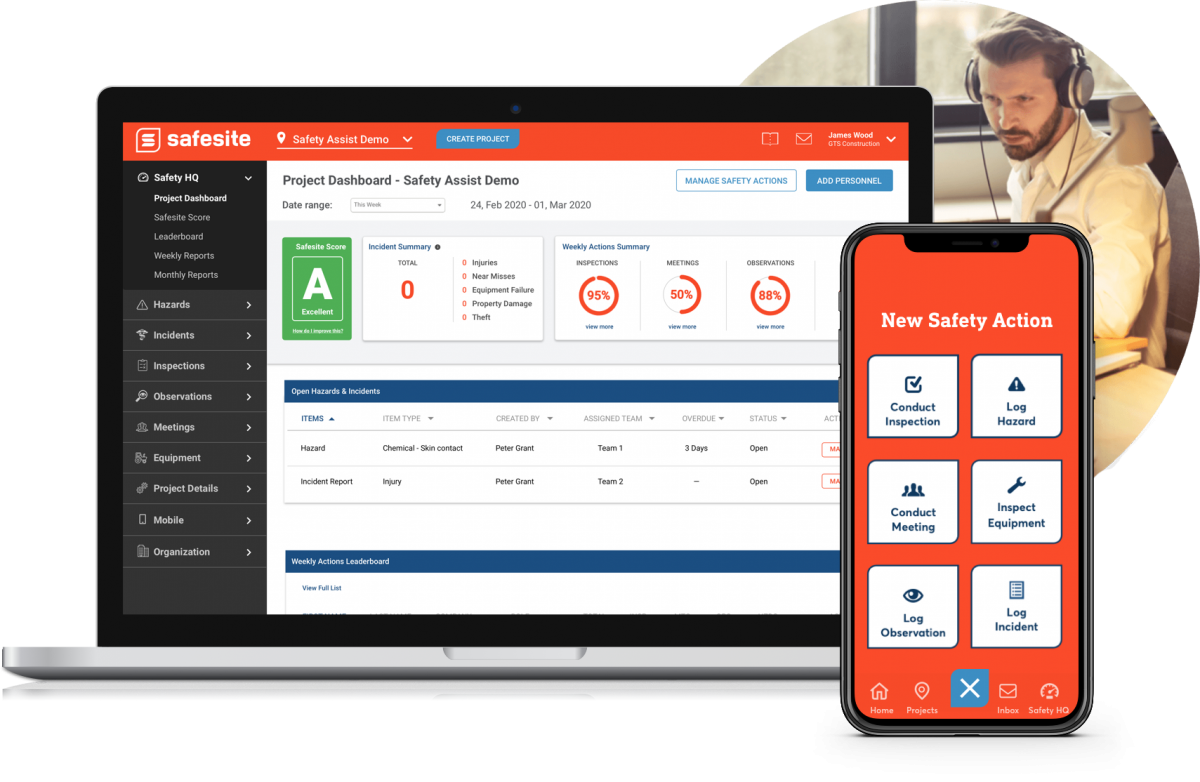You’re the brand new Safety Coordinator. You’re eager (and maybe a little nervous) to start this new chapter in your career. Likewise, your employer is expecting you to show you were the right choice for the job.
The first 100 days are a huge opportunity for you. They are a proving ground for your skills as a safety leader and officer of company standards. The first few months will set the tone for the rest of your time with your employer, so prepare to make the most of them.
To give you a leg up, we asked a number of trusted safety experts how to survive the proving ground that is the first 100 days on the job.
Want to download this article and read it later? Get the PDF straight to your device.
Get Hired as a Safety Coordinator
Before diving into day 1 on the job, let’s talk about getting hired. What do employers look for in a new safety professional? What do you need to make it out of the stack of resumes and into an interview?
While there are many titles and job descriptions that could fit your desired role — Safety Coordinator, Health & Safety Technician, Risk Manager, EHS Specialist — there aren’t as many resources out there that tell you what a successful candidate looks like.
Even now, with more opportunities than ever before, there’s no one set educational or career path that leads to a career in health and safety.
The good news is that a significant weight falls not on your years of experience but on your knowledge of applicable regulations and best practices in the industry for which you’re applying.
Pursue Coursework and Certifications
There is a certain amount of “head knowledge” that is increasingly expected of new safety hires. Herb Brychta, Security Risk Services Manager at AE Works Ltd agrees, saying:
“For new hires without much safety experience, we look for a strong technical understanding of all applicable compliance regulations. Coursework and/or certifications are preferred.”
Coursework, such as a BS degree in Occupational Health and Safety Management, and certifications provided through OSHA and the Board of Certified Safety Professionals (BCSP) are important checklist items on your resume.
BCSP certifications such as CSP, ASP, CHST, and OHST are considered the benchmark of safety professionals and are often required or preferred by organizations.
Take your credentials a step further in your cover letter and screening interview: provide examples of how you would apply your knowledge in the field.

Showcase Your Soft Skills
Any safety professional will be heavily involved in one thing: working with people! As such, a safety coordinator must be able to showcase how she relates to others during the interview process.
We asked David Paoletta, CSP, CUSP and Subject Matter Expert for Safesite, what he expects of new safety hires in the way of soft skills. He says:
“For an entry-level position, I would look for someone who is excited about the safety field and eager to learn. Those that are good listeners and have likable personalities really stand out in the interview process.”
Ultimately, each company runs a very individual process, so pay careful attention to the job requirements and find out as much as you can about the company goals and safety culture.
Learn & Connect – Day 0-100
As a new safety coordinator, you’ve already done quite a bit of learning. Hang on tight, because there is much more to come.
Being eager to learn is a key part of being a safety professional at any level. Your first 100 days as a safety manager will feature a distinct learning curve.
Make the Most of New Hire Orientation
Your new employer should offer an initial safety and skills training orientation to every single employee who walks through the doors, including you as a new safety coordinator. While you will sit through safety training extended to all new employees, your orientation will likely be tailored to your role within environmental health and safety (EHS).
During orientation, you will learn about all the applicable EHS policies and programs as well as additional training on your role within these policies and programs as a safety officer. You will also have tours of the facilities and site visits to see these policies and programs in action.
John White, CSP, ASP and Contributing Writer for Safesite, says:
“This is also your opportunity to evaluate any gaps the organization has for new hire learning as it relates to health and safety. Use this time to make note of these gaps for future use in your role.”
There’s a lot of information to absorb during orientation, and it’s impossible to take it all in as you go. That’s why it’s incredibly important to take notes or even record (with permission) each session to help you review both in the coming days but also as you go on to introduce and implement changes later.
Build Relationships
Oftentimes, you will be placed in orientation with other new hires who will be working at various levels within the organization. Use orientation as a way to connect and build relationships with these new hires and colleagues conducting the training.
Likewise, one of the first things you should do after your initial orientation is introduce yourself to each department head or site manager. Begin building lasting relationships early on.
Relationships are key to influence within the organization. Don’t just stick your head in the door: ask for a tour or take them to lunch. Ask for their thoughts on the company’s health and safety needs.
Finally, find another safety professional to shadow for a few days, if your company doesn’t require it already.

Understanding Business and Safety Goals
A huge focus of your orientation will be on the logistical details of the role — and rightfully so. However, there’s much more to orientation than policies and procedures.
Dr. Matthew Colpitts, CPO, and Founder, Consultant, and Chief Safety Officer at GoodIvy Consulting says:
“Above all, new hires must understand that safety is a core business issue. An organization that cannot manage its safety cannot manage its business. Doing safety wrong will put you out of business.”
Why is this part so important? It means that your new role may be entry-level, but it’s still critical for the success of the company.
You must understand the company’s compliance and cultural needs. What most new safety professionals overlook, though, are business and profitability goals.
Peter Grant, CEO of Safesite sums it up:
“If your employer can’t make a profit, the business will fail. If they don’t emphasize health and safety then injuries will occur, insurance premiums will rise, citations will be issued and the business will struggle to survive. Profit and safety are intertwined and essential for the sustainability of a business.”
Tip: keep a journal during your orientation and first few months on the job. Record notes and include your thoughts, ideas, and questions in addition to the technical bits you’re learning.
According to experts, your journal will not only aid you in the early days, but it will also come in handy throughout your career. It’s a great indicator of your own skill progression.
Listen – Day 0-30
One of your most important jobs as a safety professional isn’t completing paperwork or conducting presentations — it’s listening.
Your organization’s leaders and employees each have concerns, complaints, and suggestions: it’s guaranteed. It’s your job to hear them out, no matter where they’re coming from. Don’t disregard them because they don’t have the same certifications that you do.
Their relative experience in your field isn’t important because they have experience in something you might not: the day-to-day aspects of their job.
Good listening is required for you to do your job effectively, and if you’re not paying attention, your colleagues will notice.
Listen and respond to all complaints in a timely and appropriate fashion because if you don’t, you will lose their confidence. Loss of confidence won’t just harm your ability to do your job effectively. It directly impacts safety — and the entire business by extension.
Tip: Take gripes seriously. Sure, people may be letting off steam or even baiting you into an argument. Remain level-headed, gather safety observations, and sketch out a plan to improve.
Regardless of the messenger’s goodwill (or lack thereof), if there is any truth to a complaint, it’s still on you to address it.
Communicate, Communicate, Communicate – Day 30-60
Your communication skills were likely a huge part of winning your role to begin with, so keep exercising these skills throughout your first few months on the job.
During days 30-60 in particular, you’ll need to build rapport, be open about the limits of your experience, and start submitting safety observations and reports. All of these tasks require excellent written and verbal communication.
David Paoletta observes whether new hires “demonstrate real concern and empathy for the workers at all levels in the company.”
Why? As Paoletta says:
“The safety professional’s job is to communicate with people who are at ‘the tip of the spear,’ in other words, those who actually do the work.”
Be Genuine
When you’re new to a company, you’re an unknown entity. Your colleagues have preconceived notions about who you are and what you’re there to do. Want to prove yourself? Here’s how: be yourself.
Herb Brychta says:
“There isn’t one personality or appearance that works better than another for a health and safety officer. You really just have to apply the personality you’ve got.”
In other words, be genuine. Be the same person in the field and at the office, with foremen and temp workers. If you aren’t, says Brychta, coworkers at all levels will be less likely to take you seriously.
Being yourself doesn’t mean you’ll instantly be liked by everyone. By being genuine, you’re removing a barrier between yourself and success in your new role.

Communication Tips for Safety Coordinators
In addition to being genuine, there are a few ways to establish excellent communication out of the gate.
- Ask good questions. Follow up questions show you are actively listening, engaged, and seeking a deeper understanding of the matter at hand. Questions are also an easy way to get to know people.
- Admit when you don’t know the answer. Even though it’s tempting to appear knowledgeable, admitting when you don’t know something will build trust while guessing will
- Make the most of face to face time. Get business done in person when you can. While email is an efficient way to communicate, it can’t substitute for getting to hear and see the other person.
- Know when to use email. Email is excellent for coordinating and scheduling activities and other informational purposes. It’s not the best medium for handling or solving issues. It’s a good idea to watch how your superiors use email and in-person meetings and model them.
Good communication skills will serve you well in your personal and professional lives. Be intentional about developing them during your first 100 days on the job.
You catch more flies with honey than vinegar. So, don’t just reprimand people for their mistakes. Make sure you also reiterate what everyone is doing right to promote positive reinforcement and support morale.
Walk the Walk – Day 60-90
With the first 60 days under your belt, you’re already handling your new responsibilities as Safety Coordinator. This is the month to walk the walk: match your actions to your words. Don’t just say you care about your colleagues’ safety, show them.
Below are a few ways to practice safety leadership in your new job.
The Value of Long-Term Strategy VS. Quick Wins
Because your first 100 days feel like an unending audition, it’s tempting to wow your superiors with a series of quick wins. The quick wins theory says that if you can produce a result quickly, you will inspire confidence and ensure your staying power at the company.
While a quick win strategy may work well in IT or marketing, safety is a different field entirely.
For you, the wrong quick win can come at the cost of something else. For example, if you set out on an expedition to increase safety citations quickly, you could alienate field workers and have a net negative effect on your safety culture.
In the same way, if you refuse to correct any worker to quickly win trust, you may alienate those same workers when it becomes necessary to cite them down the road.
Instead, let your long-term safety strategy guide you. If your goal is to improve worker behavior, research the best ways to do so. Work with your safety committee to identify their suggested combination of safety training, engagement, positive reinforcement, and corrective reinforcement that they want to see in the field.
Another way to support your long-term strategy is to contribute original thoughts and ideas to your department. Create a safety walk template, for example, to demonstrate the value of your presence in the field. Not only will it demonstrate your knowledge, but you’ll be able to start the process of continual improvement as you practice and refine your inspections.

Address Unsafe Behaviors
Behavior will undoubtedly be the most challenging part of your job. You’ll be pressured from all sides — and maybe even from inside yourself — to snuff out bad safety habits.
Barry Rice, CSP and Environmental Health and Safety Director, PuroClean advises:
“You aren’t just a ‘safety cop.’ You have to work well with everyone in the organization to achieve your objectives.”
How do you avoid becoming the company’s enforcer? You accomplish it by listening and fostering engagement among your colleagues. Some of the ways you can do this include:
- Having an open-door policy
- Creating an anonymized system for concerns and complaints
- Seeking out regular feedback from workers in all positions
- Knowing how and when to give positive feedback
Address unsafe behaviors, but do it as a coach or teammate — not as a distant enforcer.
The Power of Positive Reinforcement
Safety is a high stakes job, and it’s not difficult to get wrapped up in all the ways things could go wrong. However, telling everyone what their mistakes are won’t win you any favors, particularly during your first 100 days.
Behavioral science tells us that positive reinforcement is one of the Safety Coordinator’s most valuable tools.
What is Positive Reinforcement in Safety?
When you use rewards or affirmation following good behavior, you’re practicing positive reinforcement. When the human brain receives a reward, it subconsciously encourages the behavior to continue.
Positive reinforcement is everywhere in our technology-driven world. One of the joys it brings is that, unlike nagging or nitpicking, it’s largely invisible as a tool for fueling change.
For example, when you get rewards points towards a free coffee with your morning cup, you’re on the receiving end of positive reinforcement from the retailer. They’re saying, “Thanks for your business. Here’s a reward so you can come back sooner.”
The simplest way to strengthen the positive feedback loop is to create a policy that consistently recognizes good behavior. Identify actions you’d like to recognize and, alongside your list, ways to reward the action. This principle of behavior-based safety can be used formally or informally, but it must be applied consistently to be effective.
Once you settle into your role, consider using your list to create a company-wide incentive program. Remember to reward those who regularly promote safety culture at work. In addition, use leading indicators to reward workers for what they do every day rather than focusing solely on lagging indicators or one-off behaviors, which don’t tell the whole story.
Safety Training and Toolbox Talks
Walking the walk is critical if you’ll be providing training or running safety meetings. It’s best to start training after some time on the job because it’s critical to tailor training to your context and your audience.
After the first few months on the job, you should have gathered a base of knowledge that will allow you to address the company’s specific scenarios and challenges.
Herb Brychta elaborates on this idea:
“Whether it’s workplace violence or COVID-19, health and safety managers need to gain an understanding of what’s included under the Duty to Protect as it’s listed under the General Duty Clause. You should have a fundamental understanding of where physical security and public health intersect with health and safety.”
Ideally, you’ll have picked up on the communication style your colleagues value most during your first 30 days. Some people like to keep it short and sweet. Others want detailed explanations of decision making. Figure out what your team wants and give it to them.
Tips for New Trainers
Communicating well during training is important — poise, confidence, and presentation skills should grow along with your training responsibilities. That’s right, you don’t have to nail your first big presentation to be a success as Safety Coordinator.
The best way to improve your training skills is to practice, whether that’s alone in front of a mirror or by putting yourself out there and doing it.
Here is one of Construction Junkie Editor Shane Hedmond’s many great training tips: gamify part of your presentation. Turning it into a game raises the stakes for the audience and takes some of the focus off you as the presenter. If you can, replicate a popular game show, like Jeopardy, and throw in a few prizes.
Apart from being an OSHA training requirement, activities break the ice and make it easier for both you and your class to focus on what’s important: applying the information when it counts.
Documentation Tools and Tech for Safety Coordinators
All new safety technicians quickly discover that the majority of what you do in the field needs to be documented. Documentation fulfills company policy and compliance requirements, absolutely, but it can also serve you well in your new role — if you have the right tools.
Safety Inspections
Document your regular safety inspections with an audit application that you can use in the field. Safesite’s free version allows you to pick a template from the library, customize it, and perform an inspection from your mobile device, taking photographs and raising hazards where needed.
Not only does documenting your inspections fulfill compliance needs, by recording them on a safety management software, you’re able to see patterns that you’d completely miss if you used paper forms.

Certification Management
Training and certifications are other areas in which documentation is key. While it’s common to record this information on excel spreadsheets, Safesite takes this information a step further and alerts you when re-training or certification is due. This takes manual calendar management off your plate and quickly adds up to hours of time saved.
Incident and Near Miss Reporting
Reporting and investigating incidents is daunting enough, but having to keep track of paper forms or spreadsheets adds an unnecessary burden. Use secure technology to make your process more efficient and give yourself more time to record what went down.
Like paper reports, digital incident reports include all of the critical information you need to record. But unlike paper, digital incident reporting allows you to perform critical steps using one tool:
- Notify essential personnel
- Record photos
- Record witness statements
- Raise and resolve hazards related to the incident
- Trend related hazards and root causes to identify problem areas
As a new employee, you may not be in a position to use technology if your company is requiring the use of their old systems. That’s okay. Familiarize yourself with the company’s way of doing things. You can present a case for using a safety app down the road — maybe sooner than you think if your company is sitting on mounds of paper forms that could transform your program if properly digitized.
Tools and technology can help you get ahead early in your role, since you’ll be spending less time at a desk and more time in the field. Research free safety apps that won’t require an investment by company stakeholders.
Grow as a Safety Coordinator – Day 100+
Congratulations on surviving your first 100 days! Hopefully, you listened as much as you talked, learned a lot (and wrote it down), and found your place within your organization.
Over the next months and years, you’ll need all the skills you used in the past 100 days. Learning, communicating, self-managing, and listening will serve you well throughout your career because as we all know: the safety landscape changes all the time.
Knowing how to research and identify the right course of action will carry you throughout your career as a safety pro. Barry Rice agrees, saying:
“It’s impossible to know everything. In order to adapt to new rules and technologies, you have to know how to find the right answers and interpret them to fit your company’s situation.”
And although you have a lot on your plate already, it’s important not to neglect your personal development as a leader and future manager. In a piece of parting advice, Rice continues:
“While you should keep it simple during the first few months on the job, at some point you should invest in leadership, public speaking, and interpersonal skills. Attending conferences and asking for feedback are two great ways to improve your leadership skills.”
Becoming a safety expert takes time. In fact, it will take your entire career. Be committed to life-long learning to grow and change, both with the organization and in response to new ideas in the field.
The Bottom Line for New Safety Coordinators
As a recap, here is some of the best advice that we heard when talking with leading safety professionals:
- Safety is a core business issue. Treat it that way.
- Build relationships and rapport with the people who actually do the work.
- Be yourself.
- Deepen your understanding of applicable safety standards, particularly the General Duty Clause.
- You are more than a rules enforcer; consider yourself a coach or champion.
- Use technology to help you minimize your time in the office and draw conclusions from data trends.
- Always keep learning. Invest in leadership and other people skills.
- Navigate the first 100 days with the future in mind.
Now it’s on you to take what you’ve learned and apply it. (You’ve got this.) Here are more tools and resources to help you do that:
